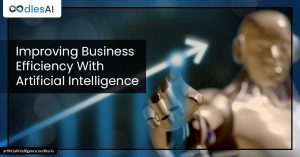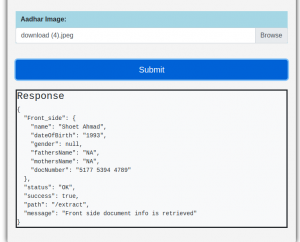How AI Cuts Indirect Costs and Improves Business Efficiency
Sanam Malhotra | 18th August 2020

The world is yet to recover from crippling economic crises stemming from the COVID-19 outbreak. As companies struggle to sustain, cost-cutting has become the ultimate weapon that is slaying jobs, salaries, and business units. However, a holistic view demands attention. Instead of pressurizing employees, organizations can empower them by welcoming Artificial Intelligence (AI). In this edition, we at Oodles, as an evolving Artificial Intelligence Development Company, explore how AI cuts indirect costs through resilient applications.
Identifying Indirect Cost Origins in a Business
Usually, General and Administrative (G&A) costs increase more slowly in comparison to revenues for global businesses. However, McKinsey Global Institute reports an upside-down trend since 2016, with G&A expenses rising faster at 15.4% contrary to 6% revenue growth.
Research reveals that AI technologies can automate almost 80% of all physical work, 70% of data processing, and 64% of data collection tasks.
Detailed anatomy of an organization’s cost structure surfaces various loopholes that flood businesses with critical yet highly overlooked expenses. Here are the major indirect cost origins that demand immediate attention through AI-led cost optimization-
1) Recruitment Cell
Human Resource (HR) activities constitute almost 70% of business operating costs. From documentation to conducting interviews and ensuring employee loyalty, HR departments consume maximum labor efforts that AI is poised to minimize.
2) Procurement Essentials
Apart from direct procurement costs related to production, indirect procurement costs envelopes the maintenance of goods and services. Examples include utilities, warehousing, IT infrastructure, etc.
3) Marketing Efforts
Customer surveys, feedback analysis, social media monitoring, and engagement generation eat away more manual hours than realized by organizations. AI’s impressive progress in developing cognitive skills is providing a strong alternate.
4) Accounting Department
Clustered with repetitive and labor-intensive tasks, accounting functions are now at the threshold of digital transformation more than ever.
With our experiential knowledge, we at Oodles, are constantly building domain-specific AI applications that serve as solutions to legacy business bottlenecks. The next section explains how we turn expenses into saving opportunities.
How AI Cuts Down Indirect Costs & Improves Efficiency
In the wake of coronavirus crises, companies are rigorously hunting for cost-reduction approaches. As technology grips control, it is incumbent for decision-makers to explore automation-driven cost-cutting methods rather than revisiting employee remunerations.
AI offers multidimensional possibilities to lower down operating costs by as much as 15 to 20 percent across business verticals.

A survey of 24 industrial companies by Mckinsey Global Research neatly segregates the impact and journey of business automation. RPA, IoT data analytics, and machine learning are poised to play a key role in automating workflows and improving efficiency.
One of the strongest factors contributing to AI-led cost reduction is the relatively lower cost of prediction.
Strategy professor, Ajay Agarwal, posits, “Businesses will use more of AI solutions for traditional prediction problems such as inventory management because we can predict faster, cheaper, and better.”
This power of AI to predict more accurate outcomes can be achieved using this 4-step implementation strategy-
1) Identifying the Right Bottleneck
Among a forest of bottlenecks, businesses must detect processes that can be automated most efficiently. A tactic is to ask- which potential process for automation can also raise the efficiency scale of other sectors? For instance, automated demand forecasting can not only improve sales but also provide expansive insights for inventory management, maintenance, and re-marketing.
2) Matching Problems with Appropriate Automation Techniques
AI is a broad discipline encompassing machine learning, Robotic Process Automation (RPA), deep learning, Natural Language Processing (NLP), computer vision, etc. Algorithms, frameworks, tools, and tech stack used for AI applications differ significantly for different use cases. To extract optimum value by investing sufficient resources, businesses must tap into AI experts and practitioners
3) Channelizing Rich Data
With the cost of prediction and sensors diminishing, the complementing cost and value of data have spiraled exponentially. Touted as ‘the new oil’, rich data is the powerhouse for every AI solution from recommendations to predictions to virtual assistants. It is, therefore, imperative for businesses to gather, utilize, and analyze their data sources to gain unparalleled insights and strengthen decisions.
4) Evaluating Performance and Impact
The last yet the most crucial step is to monitor the performance of AI-driven cost reduction applications from inception to completion. This is where human expertise is required to compare model performance with set benchmarks, time frames, budgets, and objectives. This can be initiated by tracking metrics regularly, automating reports, visualizing data, and deploying fast track applications.
Also read | Effective AI Applications For Business Automation Journey 2020
Machine Learning Applications for Cutting Indirect Costs and Improving Efficiency
The Oodles AI team assists organizations in kickstarting their automation journey with resilient applications built for agile environments. Below are some of our recent contributions to business automation pathway-
1) AI-powered OCR for Eliminating Data Entry Costs
Optical Character Recognition (OCR) is an age-old tool used for capturing and extracting data from physical and digital documents. However, OCR’s limitation in working with complex page structures, layouts, and languages renders it futile for modern business use cases.
Backed by machine learning algorithms, OCR is the most effective example of how AI cuts indirect data entry costs. With AI-OCR, businesses can now automate eKYC, purchase order and receipt digitization, digital onboarding, and other labor-intensive functions.

The above is a screengrab of an AI-powered OCR model built by the Oodles AI team to extract data from identity cards like Adhaar, passport et al. Achieving over 95% accuracy, the model can accelerate HR documentation, healthcare data management, creation of editable and searchable digital copies, and more.
Also read | AI-powered Receipt Digitization with OCR Systems for Businesses
2) Predictive Analytics to Accelerate Decision-making
Accurate predictions are the best bet for AI and machine learning. Some effective applications of data-driven predictive analytics are-
a) Demand forecasting for streamlining procurement, marketing, and sales efforts
b) Patient health analysis based on health records to predict health risks and diseases
c) Customer behavior analysis for better segmentation and targeting
d) Product or service recommendations based on purchase history data, and more.
By using data from wearable fitness gadgets, the Oodles AI team built an interactive virtual assistant providing healthcare tips and service recommendations. The application enabled business analysts to build effective strategies and products for user engagement and thereby improved customer loyalty.
In addition to predictive analytics and RPA, businesses can employ virtual assistants and chatbots to boost their marketing efforts. As a well-established Chatbot Development Company, Oodles AI has propelled lead generation processes for various organizations.
Connect with the Oodles AI Development team to explore automation opportunities for your business.



